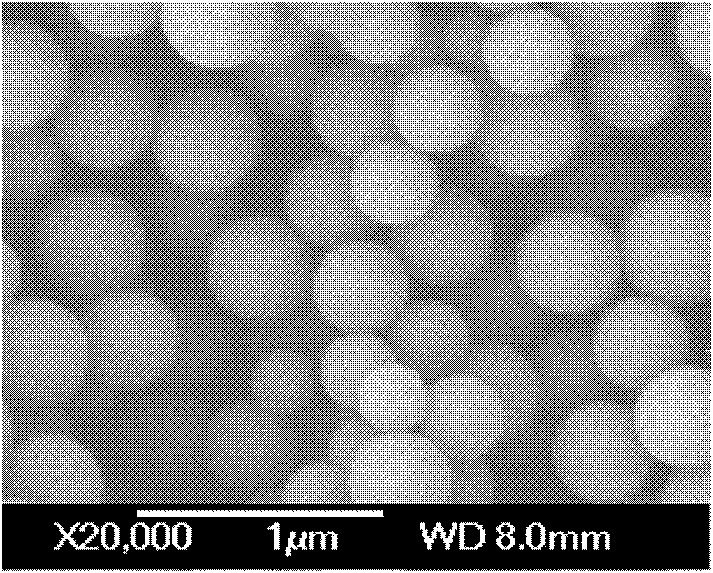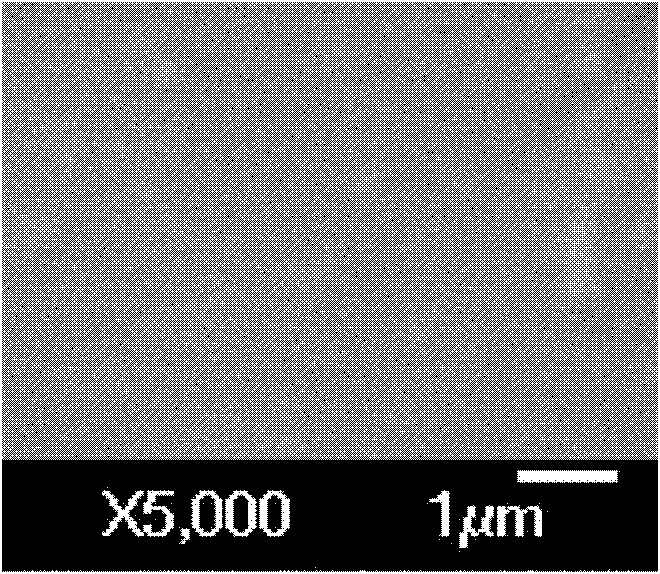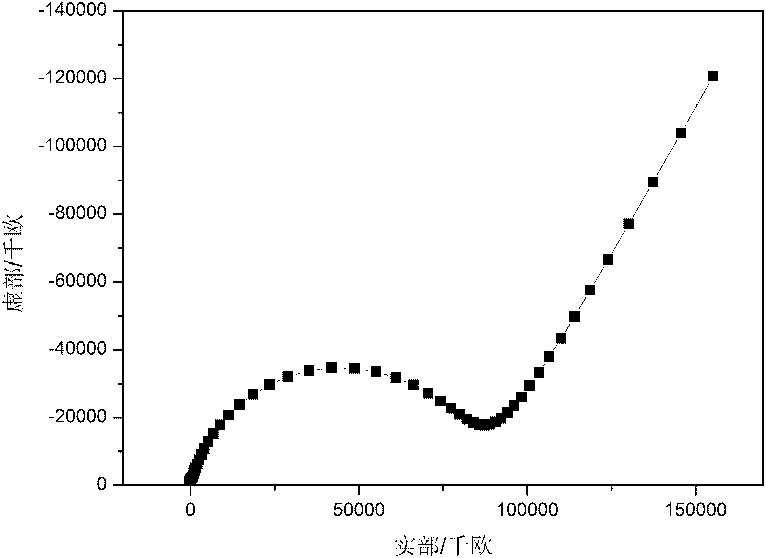Method for preparing composite solid electrolyte based on polyphosphazenes micron-sphere
A solid electrolyte, microsphere technology, applied in circuits, electrical components, secondary batteries, etc., can solve the problems of poor compatibility, ion conductivity, lithium ion migration number reduction, agglomeration, etc., and achieve good mechanical properties and thermal stability. Effect
- Summary
- Abstract
- Description
- Claims
- Application Information
AI Technical Summary
Problems solved by technology
Method used
Image
Examples
Embodiment 1
[0022] Step 1: Weigh 0.1 g of polyphosphazene microspheres, add them to 30 ml of acetonitrile, and ultrasonically disperse for 15 minutes to obtain an acetonitrile solution of polyphosphazene microspheres;
[0023] Step 2, weigh 1.0g polyoxyethylene and 0.242g LiClO respectively 4 (PEO and LiClO 4 O / Li molar ratio is 10:1), join in the acetonitrile solution of polyphosphazene microsphere, stir with magnetic stirrer for 8 hours, obtain mixed solution;
[0024] Step 3: casting the mixed solution onto a polytetrafluoroethylene template, volatilizing the solvent for 6 hours, and drying in a vacuum oven at 50° C. for 24 hours to obtain a composite solid polymer electrolyte.
[0025] Implementation effect of this embodiment: figure 1 is a scanning electron microscope (SEM) photograph of polyphosphazene microspheres (PZSMS). It can be seen from the figure that the diameter distribution of polyphosphazene microspheres is uniform and the dispersion is very good; figure 2 Scanning ...
Embodiment 2
[0027] Step 1: Weigh 0.2 g of polyphosphazene microspheres, add them to 40 ml of acetonitrile, and ultrasonically disperse for 20 minutes to obtain an acetonitrile solution of polyphosphazene microspheres;
[0028] Step 2, weigh 1.0g polyoxyethylene and 0.3025g LiClO respectively 4 (PEO and LiClO 4 The O / Li molar ratio is 8: 1), was added in the acetonitrile solution of polyphosphazene microspheres, stirred with a magnetic stirrer for 9 hours to obtain a mixed solution;
[0029] Step 3: casting the mixed solution onto a polytetrafluoroethylene template, volatilizing the solvent for 7 hours, and drying in a vacuum oven at 50° C. for 36 hours to obtain a composite solid polymer electrolyte.
[0030] Implementation effect of this example: the characterization of the composite solid polymer electrolyte is as in Example 1. The room temperature conductivity of the composite polymer electrolyte is 1.1×10 -5 S / cm, the electrochemical stability window is 4.9V, and the lithium ion mi...
Embodiment 3
[0032] Step 1: Weigh 0.3 g of polyphosphazene microspheres, add them to 40 ml of acetonitrile, and ultrasonically disperse for 30 minutes to obtain an acetonitrile solution of polyphosphazene microspheres;
[0033] Step 2, weigh 1.0g polyoxyethylene and 0.2017g LiClO respectively 4 (PEO and LiClO 4 The O / Li molar ratio is 12:1), was added in the acetonitrile solution of polyphosphazene microspheres, stirred with a magnetic stirrer for 10 hours to obtain a mixed solution;
[0034] Step 3: casting the mixed solution onto a polytetrafluoroethylene template, volatilizing the solvent for 8 hours, and drying in a vacuum oven at 50° C. for 28 hours to obtain a composite solid polymer electrolyte.
[0035]Implementation effect of this example: the characterization of the composite solid polymer electrolyte is as in Example 1. The room temperature conductivity of the composite polymer electrolyte is 1.02×10 -5 S / cm, the electrochemical stability window is 5.0V, and the lithium ion m...
PUM
 Login to View More
Login to View More Abstract
Description
Claims
Application Information
 Login to View More
Login to View More - R&D
- Intellectual Property
- Life Sciences
- Materials
- Tech Scout
- Unparalleled Data Quality
- Higher Quality Content
- 60% Fewer Hallucinations
Browse by: Latest US Patents, China's latest patents, Technical Efficacy Thesaurus, Application Domain, Technology Topic, Popular Technical Reports.
© 2025 PatSnap. All rights reserved.Legal|Privacy policy|Modern Slavery Act Transparency Statement|Sitemap|About US| Contact US: help@patsnap.com



